
International Research Journal of Engineering and Technology (IRJET) e-ISSN: 2395-0056
Volume: 11 Issue: 07 | July 2024 www.irjet.net p-ISSN: 2395-0072


International Research Journal of Engineering and Technology (IRJET) e-ISSN: 2395-0056
Volume: 11 Issue: 07 | July 2024 www.irjet.net p-ISSN: 2395-0072
Aayush Saraniya1 , Kishan Jayswal2 , Aakash Suthar3
1M. Tech Student, L.J. University, Ahmedabad.
2Kishan Jayswal, Assistant Professor, Civil Engineering Department, L.J. University, Ahmedabad, Gujarat, India.
3 Aakash Suthar, Assistant Professor, Civil Engineering Department, L.J. University, Ahmedabad, Gujarat, India
Abstract – Thisresearchinvestigatestheenhancementof concretestrengththroughfibrereinforcement,synthesizing insights from five prominent research papers. The focus centers on the impact of various fibres, such as steel, polypropylene, and glass, on concrete properties like strength, durability, and crack resistance. In conjunction with the literature review, a practical experiment was conducted involving the controlled breaking of 150x150x150mm concrete cubes And 700x150x150mm Beam.The brokencubeswere thenmeticulouslyrepaired using Fibre Reinforced Concrete (FRC) to assess the effectiveness of FRC in improving strength. Preliminary results indicate a substantial increase in compressive strengthandenhancedresistancetocrackingintherepaired cubescomparedtothecontrolgroup.Thesefindingsalign with trends observed in the literature, highlighting the positive influence of fibre reinforcement on concrete performance. The research contributes valuable insights, withthepracticalexperimentemphasizingtheapplicability ofFRCforrepairingandstrengtheningconcretestructures.
Key Words: Fibre Reinforced Concrete (FRC), Concrete strength enhancement, Fibre types (steel, polypropylene, glass), Durability, Crack resistance, Compressive strength, Concrete repair
1.INTRODUCTION
In recent years, the enhancement of concrete properties through fibre reinforcement has garnered significant attentionincivilengineeringresearch.Thisstudydelvesinto therealmoffibre-reinforcedconcrete(FRC),focusingonits profound impact on the strength, durability, and crack resistanceofconcretestructures.Bysynthesizingfindings fromprominentresearchpapers,thisinvestigationexplores theeffectsofvariousfibres,includingsteel,polypropylene, andglass,onconcreteperformance.
Centraltothisresearchisapracticalexperimentdesignedto assess the efficacy of FRC in enhancing concrete strength. The experiment involved controlled breakage and subsequentrepairof150x150x150mmconcretecubesand 700x150x150mm beams using Fibre Reinforced Concrete (FRC).Initialresultsfromtheexperimentrevealpromising outcomes, indicating a notable increase in compressive
strengthandimprovedresistancetocrackingintherepaired structurescomparedtothecontrolsamples.
Thesefindingsnotonlycorroboratetrendsobservedinthe literaturebutalsounderscorethetransformativepotential ofFRCinreinforcingandrepairingconcretestructures.By bridgingtheoreticalinsightswithpracticalapplication,this research contributes valuable knowledge to the field, emphasizingthepracticalviabilityandeffectivenessofFRC as a sustainable solution for enhancing concrete performance.
1. Comprehensive Analysis of Strengthening Techniques:
- Evaluateandanalyzeawiderangeofstrengthening techniques applied to reinforced concrete structures, encompassing both traditional and innovativemethodologies.
- Investigate external and internal reinforcement approachestoprovidea holistic understandingof theavailableoptions.
2.MechanicalBehaviorAssessment:
- Critically assess the mechanical behavior of reinforcedconcretestructures,focusingonflexural, shear, and axial capacities under various loading conditions.
- Exploreanddocumentdeformationcharacteristics resulting from the application of different strengtheningtechniques.
3.Long-termDurabilityConsiderations:
- Investigate the long-term durability aspects of strengthened structures, specifically examining resistance to environmental factors such as corrosionandchemicalexposure.
- Identify optimal strengthening strategies that contribute to the longevity of reinforced concrete elements.
4.ApplicationtoReal-worldScenarios:
- Incorporatepracticalcasestudiestoexemplifythe successful implementation of strengthening techniquesindiversestructuralsettings.
- Assesstheimplicationsofstrengthenedstructures onsustainability,consideringboth environmental andeconomicaspects.

International Research Journal of Engineering and Technology (IRJET) e-ISSN: 2395-0056
Volume: 11 Issue: 07 | July 2024 www.irjet.net p-ISSN: 2395-0072
5.SynthesisofCurrentKnowledge:
- Providea comprehensive synthesisofthecurrent state of knowledge in the field of reinforced concretestrengthening.
- Consolidate information from previous research, identify gaps in existing literature, and propose avenues for future research and innovation in structuralengineering.
6.ContributiontoPracticalDecision-making:
- Bridgethegapbetweentheoreticaladvancements and practical applications by showcasing the adaptability and effectiveness of various strengtheningtechniquesthroughreal-worldcase studies.
- Empowerengineeringpractitionerswithactionable knowledgetofacilitateinformeddecision-makingin the planning and execution of strengthening interventions.
7.AddressingChallengesofAgingInfrastructure:
- Deepentheunderstandingofchallengesassociated with aging infrastructure by examining the mechanical behavior and durability aspects of reinforced concrete structures undergoing strengthening.
- Provide a holistic perspective considering the broader implications on the resilience and sustainabilityofthebuiltenvironment.
2. METHODOLOGY
Flexural and Tensile Strength
Castingthebeam
MaterialsandEquipment
Cement:OrdinaryPortlandCement(OPC)43grade.
FineAggregates:RiversandconformingtoIS383.
CoarseAggregates:Crushedstonewithamaximumsize of20mm.
Water:Clean,potablewater.
Fibers:(asper:is148712001)
i. Naturalfibers:Jute(0.5%byvolume).
ii. Synthetic fibers: Polypropylene (0.1% by volume).
iii. Composite fibers: Composite mix (0.75% by volume).
Molds:Steelmoldswithinternaldimensionsof700 mmx150mmx150mm.
ReleaseAgent:Oilforcoatingthemolds.
MixingEquipment:Concretemixer.
CuringTank:Forwatercuringofthespecimens.
VibratingTable:Forcompactionofconcrete
Concrete Mix Design: (24 Beam sample for each grade)
M30
Water = 192 x 0.378 = 72.58 kg (Water-Cement Ratio:0.45)
Cement=427x 0.378=161.16kg
FineAggregate(Sand)=645x 0.378=243.81kg
CoarseAggregate=1110x0.378=419.58kg
M35
Cement:170.1kg
Water:72.39liters(Water-CementRatio:0.45)
CoarseAggregate:401.1kg
FineAggregate:259.98kg
M40
Cement:185.01kg
Water:70.29liters(Water-CementRatio:0.45)
FineAggregate(sand):277.52kg
CoarseAggregate:462.53kg
Step-by-Step Procedure
• Weigh the required quantities of cement, fine aggregates,coarseaggregates,andwateraccording to the mix design for each concrete grade (M30, M35,M40).
• Dry Mixing: In the concrete, first add the cement, fine aggregates, and coarse aggregates. Mix them thoroughlyindryformtoensureevendistribution
• Wet Mixing: Gradually add water while mixing to achievethedesiredworkabilityandconsistency.
• AddingFibers
• Clean the molds and apply a thin layer of release agent on the internal surfaces to facilitate easy removaloftheconcretebeamsaftercuring.
• Pourthemixedconcreteintothepreparedmoldsin 3layers.Eachlayershouldbeaboutone-thirdofthe moldheight.
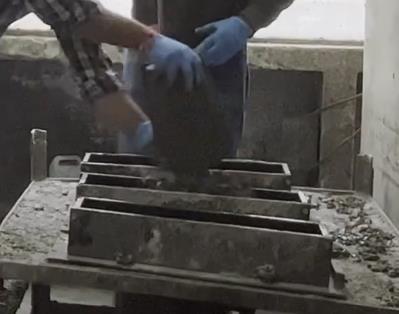
• Compaction: After placing each layer of concrete, compact it using a vibrating table to remove air bubblesandachievepropercompaction

11 Issue: 07 | July 2024 www.irjet.net p-ISSN: 2395-0072
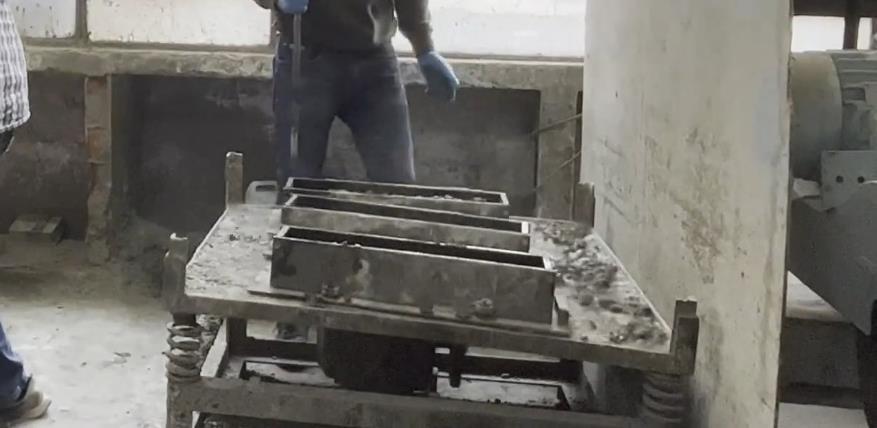
Fig -2.5 vibratingtable
• Fill the molds to the top and smooth the surface usingatrowel.
• Leave the molds undisturbed for 24 hours in a controlledenvironmenttoallowtheconcretetoset.
• After 24 hours, carefully de-mold the concrete beams.
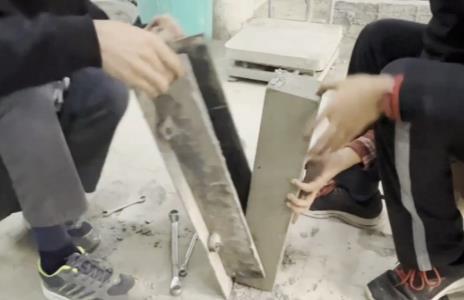
-2.6 De-mold
• Placethebeamsinacuringtankfilledwithwater. Ensurethatthebeamsarefullysubmerged
•

LOADING TEST USING UNIVERSAL TESTING MACHINE
• Positioning the Beam: Place the beam on the supportfixturesoftheUTM.
• The supports should be positioned at equal distancesfromeachendofthebeam,typicallywith
a spanlength(L)ofabout600mm (with 50 mm overhang on each side).
• Placing the Load Fixtures: Position the loading pointssymmetricallyaboutthecenterofthebeam. The distance between the two loading points (a) shouldbeone-thirdofthespanlength(L/3).Fora 700mmspan,theloadpointswillbe233mm(250 taken)apartandcentered.
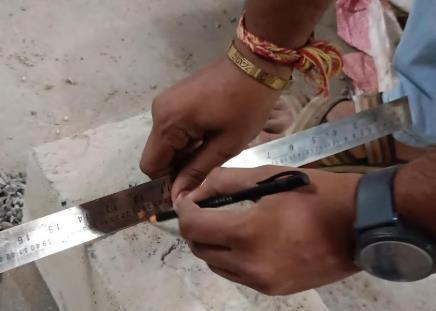
Fig -2.8 50mmoverhangoneachside
• InitialLoadApplication: Apply a small initial load to seat the beam and eliminate any slack in the system.
• Apply Load Gradually: Start the UTM and apply loadgraduallyataconstantrate.Theloadshouldbe applied through the two loading points. 30n/m loading rate
• Monitor and Record Data:Continuouslymonitor andrecordtheloadandcorrespondingdeflectionat regularintervals.Notetheinitialcrackingloadand anysignificantchangesinthebeambehavior.
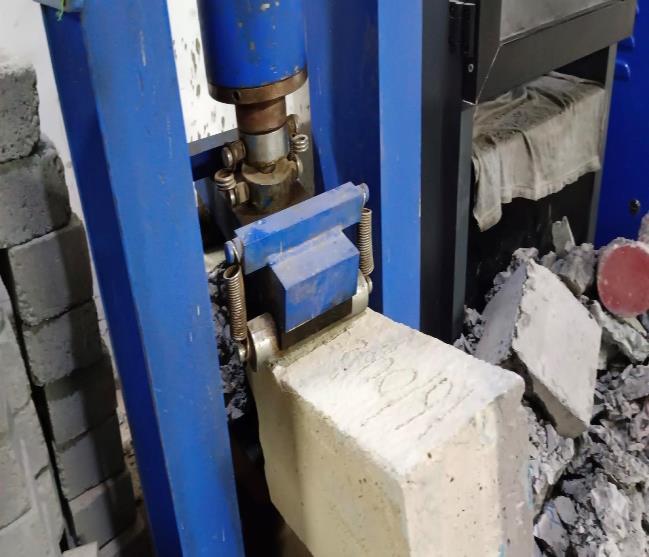
Fig -2.9 Applyloading
• Remove the Beam:Carefullyremovethebroken beamfromtheUTM.
• Measure Crack Widths andrecordthecrack widthsandpatternsusingaruler.

International Research Journal of Engineering and Technology (IRJET) e-ISSN: 2395-0056
Volume: 11 Issue: 07 | July 2024 www.irjet.net p-ISSN: 2395-0072
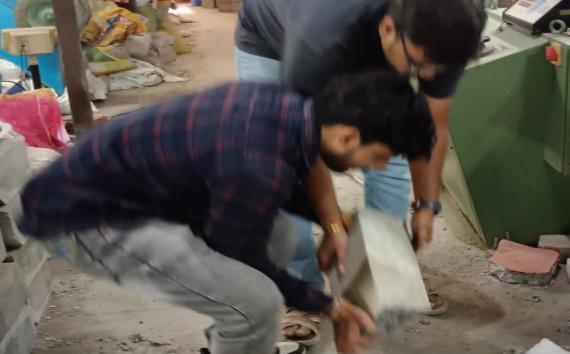
Calculations
FlexuralStrengthCalculation:
if"a"isgreaterthan20cmfor15cmspecimen: Flexuralstrength (fb) = PL/BD2
if"a"islessthan20cmbutgraterthan17cmfor 15cmspecimen:FlexuralStrength fr=3PL/2BD^2
Where“a”isminimumdistancebetweencrackto Support
• fr FlexuralStrength
• P istheload
• L istheSpanlength
• b isthewidth
• d isthedepth
TensileStrengthCalculation: Ft=k*fr
• ft isthetensilestrength,
• fr istheflexuralstrength,
• k isaconversionfactorthatdependsonthe materialanditscondition. Fortypicalconcrete,theconversionfactor k isoftentaken tobearound0.7to0.75.
3. OBSERVATION
Avg. peak load
Table -3.1: Avg. Peak Loading for M30

Table -3.2: Avg. Peak Loading for M35

Table -3.3: Avg. Peak Loading for M40

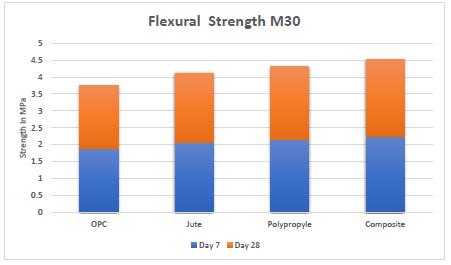
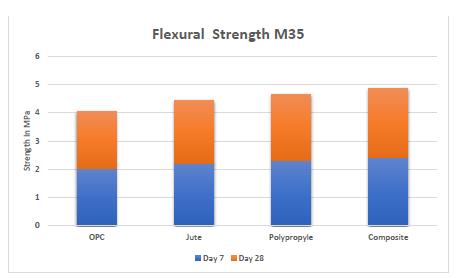

International Research Journal of Engineering and Technology (IRJET) e-ISSN: 2395-0056
Volume: 11 Issue: 07 | July 2024 www.irjet.net p-ISSN: 2395-0072
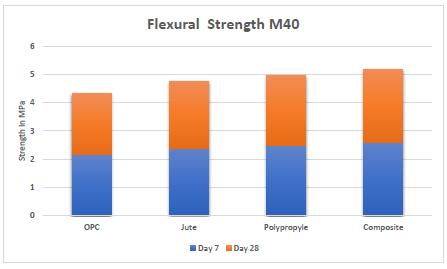
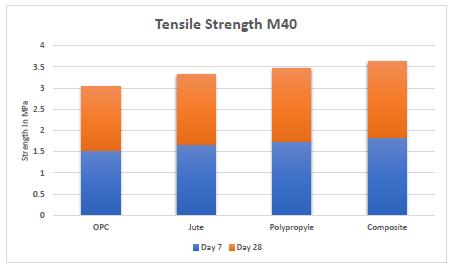
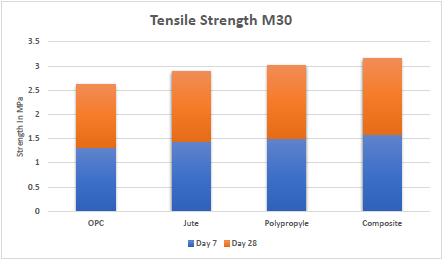
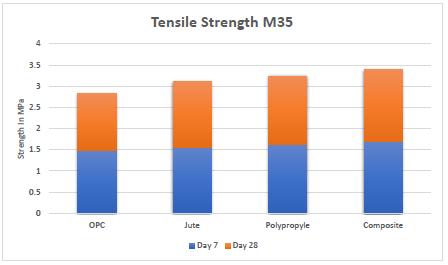
Day 7 observation
Table -3.4: Flexural and Tensile Strength of M30 on day 7
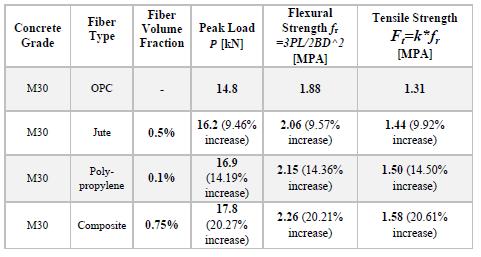
Table -3.5: Flexural and Tensile Strength of M35 on day 7
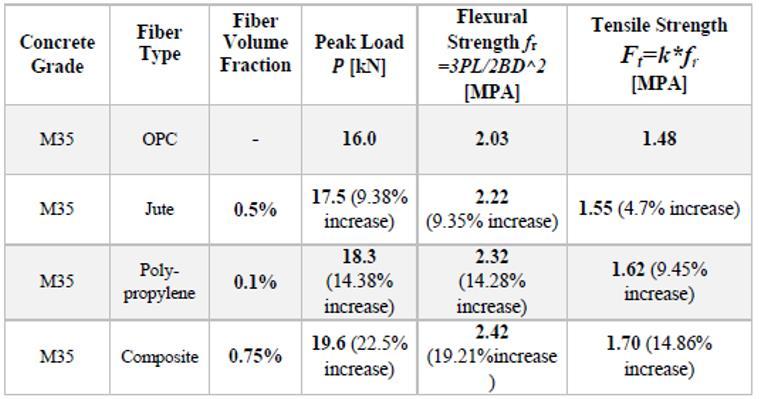

International Research Journal of Engineering and Technology (IRJET) e-ISSN: 2395-0056
Volume: 11 Issue: 07 | July 2024 www.irjet.net p-ISSN: 2395-0072
Table -3.6: Flexural and Tensile Strength of M40 on day 7
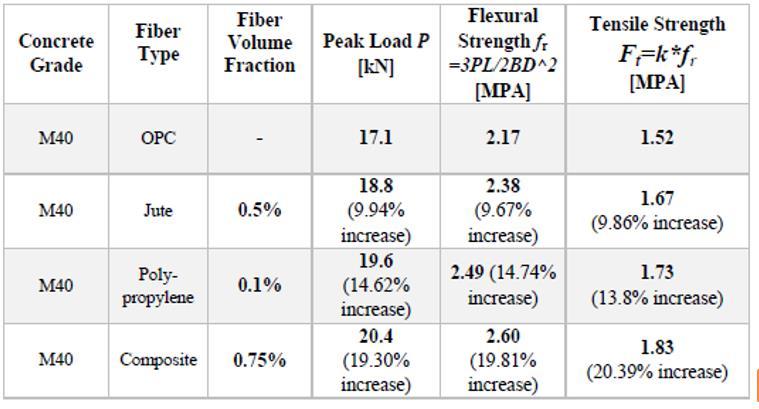
Table -3.7: Flexural and Tensile Strength of M30 on day 28

Table -3.8: Flexural and Tensile Strength of M35 on day 28
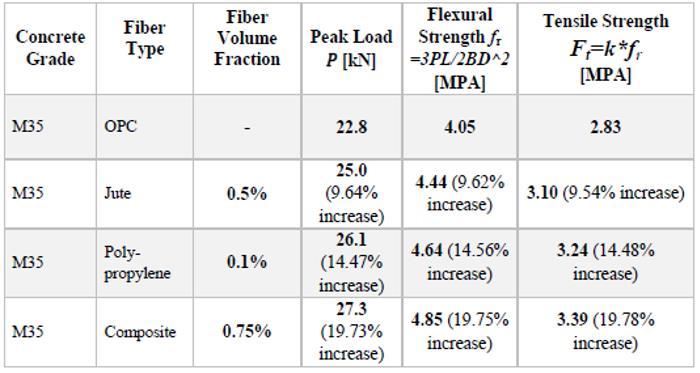
Table -3.9: Flexural and Tensile Strength of M40 on day 28
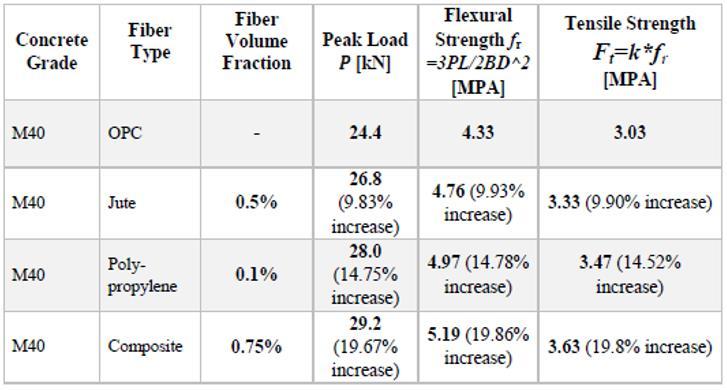
• Enhanced Strength: Fiber reinforcement in concrete significantly improves its flexural and tensile strengths comparedtoconventionalconcrete.
• Optimal Fiber Volume: Composite fibers at a 0.75% of volumefractionshowedthehigheststrengthgainsamong allfibertypestested.
• TheCompositeFiberIncreasesStrengthUpto20%for7 dayand28days.
• The Jute fiber is the cheapest fiber in our study and it increases strength up to 10%. But You cant add high amount of jute because its effect more on workability comparetoPolypropylen.
• Superior Performance of Composite Fibers: Composite fibersconsistentlyoutperformedJuteandPolypropylene fibersinbothflexuralandtensilestrengthtests.
• Grade Variation: The improvements in mechanical propertieswereevidentacrossallconcretegrades(M30, M35, and M40), demonstrating the versatility of fiber reinforcement.
• Early Strength Gain: Even at 7 days, fiber-reinforced concrete samples showed noticeable improvements in strength,indicatingearlystrengthgain.
• Long-term Benefits: At 28 days, the enhancements in strength were more pronounced, suggesting that fiber reinforcementcontributestolong-termdurability.
• UniformDistribution:Propermixingandcompactionare crucialtoensuretheuniformdistributionoffiberswithin theconcretematrix.
• Cost-EffectiveSolution:Fiberreinforcementcanbeacosteffective way to enhance concrete properties without significantlyincreasingthematerialcost.
• PracticalApplications:Fiber-reinforcedconcreteissuitable forstructuralapplicationswhereincreasedload-bearing capacityanddurabilityarerequired.
• Environmental Considerations: The use of natural fibers likeJutecanbebeneficialforenvironmentallysustainable constructionpractices.
• Future Durability Studies: Further investigation into the long-term durability of fiber-reinforced concrete under variousenvironmentalconditionsisrecommended.
• ImplementationGuidelines:Thefindingssuggestpractical guidelines for incorporating fibers into concrete mixes, optimizingbothperformanceandcost-efficiency.

International Research Journal of Engineering and Technology (IRJET) e-ISSN: 2395-0056
Volume: 11 Issue: 07 | July 2024 www.irjet.net p-ISSN: 2395-0072
[1] https://www.sciencedirect.com
[2] https://www.mdpi.com/
[3] https://www.hindawi.com/
[4] https://www.google.com/
[5] ACICommittee318,1995,
[6] “Building Code Requirements for Structural Concrete (ACI 318-95) and Commentary (318R95),”
[7] American Concrete Institute, Farmington Hills, Mich.,369pp.ACI-ASCECommittee426,1973,
[8] “The Shear Strength of Reinforced Concrete Members Chapters1to4,”
[9] Proceedings, Journal of the Structural Division, ASCE, V. 99, No. ST6, June, pp. 1091-1187. Jay H. Paul, S.E., P.E." Repair, Renovation and StrengtheningofConcreteStructures".
[10] “Evaluation and Rehabilitation of Concrete Structures”MexicoCity,September11-13,2002.
[11] AndersCarolin."CarbonFibreReinforcedPolymers forStrengtheningofStructuralElements".
a. Ph.D. Thesis, Department of Civil and MiningEngineering,DivisionofStructural Engineering, Luleå University of Technology,Sweden,2003
2024, IRJET | Impact Factor value: 8.226 | ISO 9001:2008